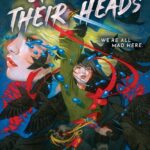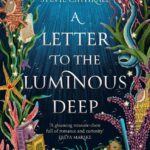

Genres: Queer Protagonists, Secondary World Fantasy
Representation: Pansexual MC, lesbian love interest, major asexual nonbinary character, past F/F, F/F/M polyamory
ISBN: 1250776600
Goodreads

A pansexual bloodmage reluctantly teams up with an undead spirit to start a rebellion among the living and the dead.
In Thanopolis, those gifted with magic are assigned undead spirits to guard them—and control them. Ever since Rovan’s father died trying to keep her from this fate, she’s hidden her magic. But when she accidentally reveals her powers, she’s bound to a spirit and thrust into a world of palace intrigue and deception.
Desperate to escape, Rovan finds herself falling for two people she can’t fully trust: Lydea, a beguiling, rebellious princess; and Ivrilos, the handsome spirit with the ability to control Rovan, body and soul.
Together, they uncover a secret that will destroy Thanopolis. To save them all, Rovan will have to start a rebellion in both the mortal world and the underworld, and find a way to trust the princess and spirit battling for her heart—if she doesn’t betray them first.
I received this book for free from the publisher via NetGalley in exchange for an honest review. This does not affect my opinion of the book or the content of my review.
Highlights
~Everyone cool is queer
~not-gory blood magic!!!
~ghosts can be hotties too
~poly + found-family FTW
In The Ravenous Dark is pretty boundary-pushing for YA Fantasy – this is one of the first times I’ve seen a pansexual main character, for example, and while it’s not quite the first polyamorous YA Fantasy I’ve seen, it is only the second. Strickland is quite happy to go where few others dare to tread, and I applaud it.
But as much as I wanted to, I didn’t end up loving this book.
And in total fairness, I don’t think it’s because it’s a bad book. I think it’s me. I’ve been struggling more and more with YA lately, and it might be time to call it quits. Because the things I didn’t enjoy about In The Ravenous Dark are all more to do with YA styles and conventions than anything else, and those aren’t flaws when the book is, you know, YA. They’re features, not bugs.
So I’m going to break this down, being as objective as I possibly can.
The Good
The cast was great. It was a nice if disorientating change to have a main character who drinks too much and is also illiterate; Rovan does not walk onto the stage as an all-powerful badass. She has a temper, she can be nasty and vicious, she can act without thinking. All of these things make her interesting, and they make her feel very human. Lydea, Rovan’s female love interest, had plenty of dark-and-sexy vibes, and gradually let Rovan inside her defenses in a way that worked for me. Ivrilos, Rovan’s male love interest, was conflicted and complicated and really Not a Nice Guy, which earns him points in my book.
And of course Japha, Rovan’s best friend inside the palace, was absolutely the star of the show: an asexual, nonbinary fashionista who always manages to look fabulous, say something clever, and be there when you need them. I will be surprised if most readers don’t walk away from In The Ravenous Dark with Japha as their favourite character; they were certainly my favourite!
The found-family vibes Are Strong In This One. The developing relationships tying Rovan, Japha, Lydea, and Ivrilos together made my heart melt, and seeing them repeatedly back each other up and stand together was beyond heart-warming (although you should be warned: it takes a while for Ivrilos to get on board). But I also enjoyed the fact that it’s not all smooth sailing; there are misunderstandings and thoughtlessness and outright fuck-ups that cause tension and pain. Theirs is a very unconventional set-up, and it’s not easy to bring it all together – but it’s so worth it, because the end result is priceless.
And on that note: Strickland is not afraid to go there. Although the story never got very gory (thank goodness, I don’t do well with gore) it definitely gets plenty dark, emotionally, and Strickland doesn’t pull their punches. The lines most authors won’t cross? Get crossed here. And it’s very difficult to talk about that without spoilers, so let me just say that I was and am impressed that Bad Things Happen, even to people we like, even in ways that we are trained, as readers, to expect will work out okay. I spent a good chunk of this book thinking well, that would be bad, but it won’t actually HAPPEN because the worst never happens in books so it’s fine – and then The Thing would happen.
Nobody’s safe, and I think that’s a good thing. It’s brave and it’s interesting and it keeps the reader on their toes.
I’m also a terribly shallow person and loved the glimpses we got of Skylea, the homeland of Rovan’s father, because it was all just so pretty. Cities in trees! Magic-coloured hair! White tigers! There were definitely some elven/fae vibes and I would have loved to have gotten to see more of it.
The Bad
I found the second half of the book a bit rushed, and the twists and turns and reveals were mostly pretty predictable. That said, they were predictable in a vaguely YA way (I have no idea how to better explain what I mean, readers who read both YA and Adult will hopefully understand???) so if you enjoy YA Fantasy in general, I don’t think it’ll bother you.
The worldbuilding initially looked like it was going to be really interesting, but then it kind of faded out. The magic systems = awesome; the worldbuilding, not so much. I always have so many questions when underworlds/afterlives/Realms of the Dead are involved, and they were not answered here. Again, it’s difficult to discuss without going into spoilers, but I found the underworld and how it worked incredibly simplistic.
I also wasn’t really interested in any of the villains. One of the more minor ones revealed some unexpected depth at the last moment, but then is promptly Taken Out, so. The rest, the Big Bads? Were just…blandly evil. No complex motivations or even an interesting set of goals. They were also extremely misogynistic, which was never explained. Don’t get me wrong, the misogyny helped me despise them and the system they’d built, but I would have liked to know why they hated women so much. Blegh.
Finally, as much as I loved Lydea and Rovan’s relationship and how it developed, Rovan’s relationship to Ivrilos – which is initially pretty damn complicated, with power dynamic issues and betrayals and lies all mixed up together – turned romantic…not out of nowhere, but I wasn’t super happy with how the Issues that made Rovan dislike and distrust Ivrilos were all kind of brushed aside more than resolved once it was Romance Time. Although under the circumstances I very much understand why Ivrilos makes his declaration of love when he does, I had a hard time believing that Rovan would immediately forget all the crap he’d pulled previous to that point.
(I did immensely approve of the fact that Ivrilos just makes heart-eyes when Rovan goes full-on scary-monstrous. Give me all the guys who adore their terrifying girlfriends, please!)
The Extremely Not-Great
The first sex scene in the book, which takes place between two women, is a fade-to-black. That’s fine with me; I rarely enjoy explicit sex scenes, so I’m perfectly happy when the narrative decides to skip them.
…What’s less cool is when the F/F scene is fade-to-black, but your F/M sex scene is explicit. Because then you’re treating the two kinds of sex – I don’t want to say ‘queer sex and straight sex’, because the F/M scene is not straight sex, at least one of the participants is queer even if they are, at that moment, engaging in sex with someone of the opposite gender. Doesn’t matter, doesn’t make them straight.
And I want to be charitable and say that maybe Strickland wasn’t confident in their ability to write F/F sex, and that’s why it’s not there. But in that case, both sex scenes ought to have been fade-to-black. Fading to black on one but not the other…it reads as, ‘this kind of sex is Not Suitable for Young People to read about, but this one is totally fine’. It’s like saying F/F is dirty or only suitable for porn, whereas sex between a man and a woman is healthy and fine and nothing to worry about. Otherwise, why would you ‘censor’ one but not the other?
I seriously doubt Strickland intended to make it feel that way, and I am deeply suspicious that someone in the editing process insisted on a F/F sex scene being cut if the book was going to be published – we’ve seen that before. But however and whyever it happened, it left me with a pretty bad taste in my mouth.
In Conclusion
All in all, I did enjoy this, and I especially loved how so many aspects of it push convention (I desperately want to write an essay on how Strickland totally subverts the Bury Your Gays trope!!!) I wish it had been written as Adult rather than YA, but as a YA novel, it’s a great standalone fantasy with some fab non-traditional queer rep, that goes places I’ve rarely seen YA Fantasy go. My personal feelings might be a bit mixed, but I did enjoy reading it, and I definitely recommend it if a dark, queer, YA story is what you’re looking for.







Leave a Reply